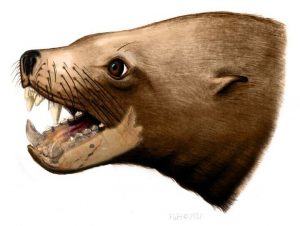
An Otago-led team of scientists using techniques from the field of dentistry is shedding new light on the evolution of walruses, fur seals and sea lions. The researchers have cast further doubt on previous claims that an ancient “killer walrus” was a marine mammal eater.
In a newly published article in the international journal The Science of Nature the multidisciplinary team of researchers report their analysis of the internal structure of tooth enamel in a fossil walrus from California, Pelagiarctos thomasi, and in teeth of modern pinnipeds the New Zealand fur seal and sea lion.
Study co-author Dr Carolina Loch says this was the first time the enamel ultrastructure of fur seals and sea lions, as well as the extinct walrus Pelagiarctos, was studied using scanning electron microscopy.
“Pelagiarctos was originally thought to have been a “killer walrus” that fed on large prey such as other marine mammals, but we found it has an enamel layer reasonably similar to that of modern New Zealand fur seals and sea lions, which are fish and squid eaters,” Dr Loch says.
The enamel structure the researchers identified in Pelagiarctos meant the walrus was unlikely to be up to crunching through large bones without cracking its teeth — suggesting that it was a dietary generalist like the modern New Zealand pinnipeds studied, she says.
Dr Loch says the study showed how using techniques and methods commonly employed in dentistry can answer questions with broader implications in the biology and evolution of animal species.
“Features and structures of the enamel layer have long been associated with differences in diet and tooth usage among animals, and can also help in the understanding the relationships among fossil and living species.
“Teeth are not only the focus of modern dentistry, but also valuable tools for biologists, archaeologists and paleontologists,” Dr Loch says.
The study was conducted by Dr Loch, research fellow at the University of Otago’s Sir John Walsh Research Institute, Faculty of Dentistry (and Otago alumna — Department of Geology and Faculty of Dentistry); Dr Robert Boessenecker, College of Charleston USA (and Otago alumni — Department of Geology); Dr Morgan Churchill (New York Institute of Technology College of Osteopathic Medicine, USA) and the late Professor Jules Kieser (Otago Faculty of Dentistry) — who is always remembered for his prolific multidisciplinary dental research.
A 2013 paper by Drs Boessenecker and Churchill was the first to cast doubt on the “killer walrus” claims and the latest findings bolster their case, Dr Loch says.
Reference:
Carolina Loch, Robert W. Boessenecker, Morgan Churchill, Jules Kieser. Enamel ultrastructure of fossil and modern pinnipeds: evaluating hypotheses of feeding adaptations in the extinct walrus Pelagiarctos. The Science of Nature, 2016; 103 (5-6) DOI: 10.1007/s00114-016-1366-z
Note: The above post is reprinted from materials provided by University of Otago.










